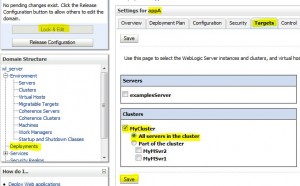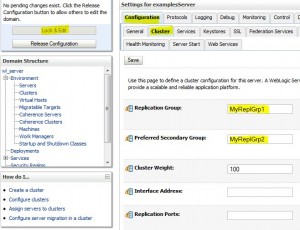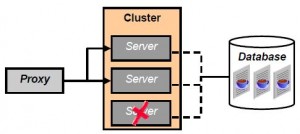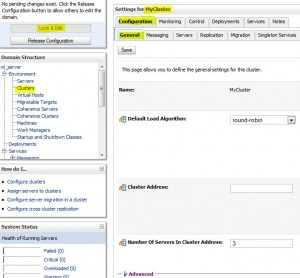Contents
- Deploy an application to a cluster
- Describe the replication of a session state in a cluster
- Configure replication groups
- Configure in-memory session replication
- Configure Java Database Connectivity (JDBC) session replication
- Configure file session replication
- Describe state replication for stateful session EJBs
<< Previous
Deploy an application to a cluster
* Applications are deployed using the two phase deployment (TPD) approach:
– phase 1: distribute components/modules to all server instances
– phase 2: if phase 1 succeed, applications are deployed to allow client access
* Relaxed deployment mode:
– if one or more server instances are not available/reachable (these servers are called partitioned server), deployment continues to available server instances
– when partitioned servers become reachable, deployment starts on these servers (potential performance hit)
* Relaxed deployment mode can be disabled by setting enforceClusterConstraints to true with weblogic.Deployer
* Production redeployment in a cluster
– may result in both older and new versions running simultaneously
– older version always fails to same older version (fail if none exists)
Describe the replication of a session state in a cluster
HTTP Session Replication
* Supports:
– in-memory replication: each user session always exists in two servers (primary and secondary servers)
– JDBC persistence
– file persistence
* Configured within each web application
– in weblogic.xml: session-descriptor
* All web servers should have identical configuration
* WLS also supports AsyncRep to improve cluster performance
In Memory Replication
* WLS supports in memory replication for:
– HttpSession objects
– Statefull session beans
* Session objects exist only on two servers: primary server and secondary server
* Primary/secondary servers are determined by replication group and machine definition
* Clients must access the cluster using one of the following:
– WLS aware hardware load balancer: LB must support SSL persistence and passive cookie persistence to allow cookie persistence between client and WLS
– OHS with mod_wl_ohs
– One or more web servers with WebLogic proxy plug-ins configured identically (WebLogic proxy plug-ins only supports round robin load balancing)
– Oracle WebLogic Server configured with HTTPClusterServlet
Configure replication groups
* Logical grouping of related servers in a cluster
* Used to decide where to put in-memory backup objects (preferred replication group)
* Better than using machines since one physical computer may have multiple IP addresses (machines)
Configure in-memory session replication
* Use weblogic.xml:
<session-descriptor> <persistent-store-type>replicated</persistent-store-type> </session-descriptor>
* persistent-store-type:
– memory: Disables persistent session storage.
– replicated: Same as memory, but session data is replicated across the clustered servers.
– replicated_if_clustered: If the Web application is deployed on a clustered server, the in-effect persistent-store-type will be replicated. Otherwise, memory is the default.
– async-replicated: Enables asynchronous session replication in an application or web application. See Configuring Session Persistence.
– async-replicated-if-clustered: Enables asynchronous session replication in an application or web application when deployed to a cluster environment. If deployed to a single server environment, then the – – session persistence/replication defaults to in-memory. This allows testing on a single server without deployment errors.
– file: Uses file-based persistence (See also persistent-store-dir).
– async-jdbc: Enables asynchronous JDBC persistence for HTTP sessions in an application or web application. See Configuring Session Persistence.
– jdbc: Uses a database to store persistent sessions. (see also persistent-store-pool).
– cookie: All session data is stored in a cookie in the user’s browser.
Configure Java Database Connectivity (JDBC) session replication
* Advantages:
– No primary/secondary needed.
– All members of a cluster have access to any client’s session data
* Disadvantages:
– Performance hit
Configure JDBC Persistence
* Create required wl_servlet_sessions table in database:
CREATE TABLE wl_servlet_sessions ( wl_id VARCHAR2(100) NOT NULL, wl_context_path VARCHAR2(100) NOT NULL, wl_is_new CHAR(1), wl_create_time NUMBER(20), wl_is_valid CHAR(1), wl_session_values LONG RAW, wl_access_time NUMBER(20), wl_max_inactive_interval INTEGER, PRIMARY KEY (wl_id, wl_context_path) );
* Create JDBC data source that has read/write privileges to the database
* Configure weblogic.xml:
<session-descriptor> <persistent-store-type>jdbc</persistent-store-type> <persistent-store-pool>MyDataSource</persistent-store-pool> </session-descriptor>
Configure file session replication
* Create a folder shared by all servers on the cluster on a HA file system
* Assign read/write privileges to the folder
* Configure weblogic.xml
<session-descriptor> <persistent-store-type>file</persistent-store-type> <persistent-store-dir>/mnt/wls_share</persistent-store-dir> </session-descriptor>
HTTP State Management Best Practices
* Create WLS machines
* Use Replication Groups
* Choose replication strategy
* Use ServerDebugConfig MBean to debug session replication
* Ensure objects are serializable
Describe state replication for stateful session EJBs
* Achieved via replica-aware stubs
* Replica-aware stubs are generated at compile time for clusterable EJBs
* Supported algorithms:
– round robin
– weight based
– random
– parameter based (custom programming)
* Also uses server affinity so that calls to objects remain with the same server
Configure Deployment Descriptors
* For EJB 2, configure in weblogic-ejb-jar.xml or weblogic-cmp-rdbms-jar.xml:
<stateless-clustering> <stateless-bean-is-clusterable>True</stateless-bean-is-clusterable> <stateless-bean-load-algorithm>random</stateless-bean-load-algorithm> </stateless-clustering>
* For pure EJB 3, use deployment plan
* For EJB 3 that supports backward compatibility with EJB 2, configure like EJB 2
* Stateless session bean in weblogic-ejb-jar.xml
<stateless-session-descriptor> <!–- Other Tags As Appropriate Here… --> <stateless-clustering> <stateless-bean-is-clusterable>True</stateless-bean-is-clusterable> <stateless-bean-load-algorithm>random</stateless-bean-load-algorithm> <!–- Other Tags As Appropriate Here… --> </stateless-clustering>
* Stateful session bean in weblogic-ejb-jar.xml
<stateful-session-descriptor> <stateful-session-clustering> <home-is-clusterable>true</home-is-clusterable> <home-load-algorithm>random</home-load-algorithm> .... <!-- None for not to replicate --> <replication-type>InMemory</replication-type> </stateful-session-clustering> </stateful-session-descriptor>
* Entity bean in weblogic-ejb-jar.xml
<entity-clustering> <home-is-clusterable>True</home-is-clusterable> <home-load-algorithm>random</home-load-algorithm> <home-call-router-class-name>beanRouter</home-call-router-class-name> </entity-clustering>
Configure EJB Clustering using Admin Console
* Configures default EJB cluster settings for the domain
EJB Best Practices
* Set pool and cache sizes accordingly
* Cache size affects all nodes in the cluster
* Mark bean as idempotent at either bean or method level in weblogic-ejb-jar.xml
– bean level:
<stateless-bean-methods-are-idempotent>true</stateless-bean-methods-are-idempotent>
– method level:
<dempotent-methods>true</dempotent-methods>
Next >>
[mv_include id=’3268′]




